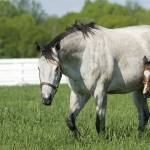Nutritional Management of the Mare and Foal

In his study, “Review of Calcium requirements of pregnant mares,” Harold F. Hintz says that the NRC Subcommittee on Horse Nutrition has consistently raised its recommendations for calcium levels in broodmare diets. In fact, the recommendation has been doubled between 1949 (16.5 grams per day) and 1989 (35 to 37 grams per day) for a 500-kilogram mare in late gestation.
Estimates by French and German equine nutritionists are similar to current NRC recommendations. The author mentions a recent study by Martin et al. that looked at serum concentrations of calcium and parathyroid hormones when mares were fed diets containing lower or higher calcium concentrations. The study showed less disruption of serum calcium and parathyroid hormone in the mares fed higher concentrations of calcium.
Hintz concludes that the increases in NRC calcium recommendations are supported by data from a number of independent sources.
Protein
The author relates the results of a South African study in which nonpregnant mares were fed one of four diets. The basal diet contained pellets made of cottonseed meal and sunflower meal, neither of which offers high-quality protein, and tef hay, a common regional hay. In treatment two, tef hay was replaced with alfalfa hay to increase the concentration of protein and essential amino acids. Treatments three and four included the addition of fish meal to the tef and alfalfa diets, respectively, to increase methionine and lysine availability. Mares on the fish meal diets had larger ovarian size and greater follicular development, and ovulated two to three weeks earlier than mares on the other diets.
Pregnant mares on the four diets produced foals with similar birth weights. Mares on pellets and hay lost weight during lactation, while those supplemented with 200 grams of fish meal gained weight. The author concluded that this fairly small increase in high-quality protein in the diet of pregnant and lactating mares significantly influenced foal growth. He recommended that broodmare diets should contain sufficient high-quality protein to prevent embryonic loss, maintain body reserves, and support milk production.
Nutritional Secondary Hyperparathyroidism
Nutritional secondary hyperparathyroidism (NSH) is caused by feeding a diet low in calcium and high in phosphorus. The result of such an imbalance is a rise in parathyroid hormone which causes the removal of calcium from the bones to maintain the necessary blood level of calcium. Fibrous connective tissue then develops, causing a noticeable enlargement of the facial bones. Lameness is an accompanying sign in some horses. NSH is rare today, but is still occasionally encountered. It may be related to equine diets containing too much grain and too little hay, feeding high levels of wheat bran without supplemental calcium, or grazing tropical pastures which may be high in calcium-binding oxalates. NSH can be prevented by educating horse owners about the importance of adequate dietary calcium and balanced calcium/phosphorus ratios.
Feeding the Broodmare
In his study, Dr. Joe Pagan states that broodmare nutrition must match the mare’s needs at each stage: barren/early pregnancy, late pregnancy, and lactation.
Barren mares and those in the first seven months of pregnancy may not need high levels of supplementation, especially if they have access to good-quality pasture. Because the equine fetus develops very slowly during this period, demands on the mare are increased only minimally over maintenance. Overfeeding can easily lead to obesity and difficulties at foaling.
After the seventh month of pregnancy the fetus develops much more rapidly, and the mare needs increased energy, calcium, phosphorus, and high-quality protein. Trace mineral supplementation must be adequate to allow the fetus to store iron, zinc, copper, and manganese to sustain growth during the first few months when the mare’s milk does not provide these nutrients. Feeding to the point where the mare becomes fat is still not a good idea, and mares that tend to become obese can be switched to a low-energy supplement that provides adequate vitamin and mineral levels.
Lactating mares use energy, calcium, and phosphorus at a greatly increased rate. Trace minerals are of less importance. Ten to fourteen pounds of grain per day may be necessary to meet the demands of milk production. Ideally the mare’s grain ration should be slowly increased to this level during the last few weeks of pregnancy, avoiding a significant change in diet just after foaling. The mare’s needs decrease as milk production slows after the first three months, and grain amounts should begin to taper off at this point.
The full texts of these papers can be found in “Comprehensive Preventative Medicine for the Mare and Foal Highlighting Nutritional Management and Developmental Orthopedic Disease” produced by Hilltop Farm, Inc., 1089 Nesbitt Road, Colora, MD 21917.








